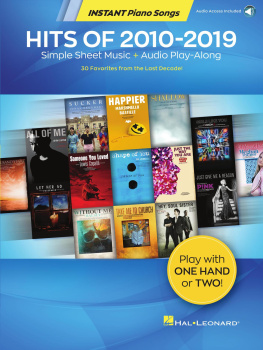Id like to dedicate this book to my lovely family: my wife, Alli, my son, Lennon, and my daughter, Leherie. Id also like to dedicate it to my parents, Mike and Kay, and my sister Mika for their continued support throughout the years. They had to endure a lot of ugly guitar noises emanating from my room during my formative years. (Now, of course, they cant hear those ugly noises anymore; I moved out long ago.)
Thanks much to the staff at Hal Leonard Corporation for their hard work and dedication to putting out such high-quality products.
Introduction
Welcome to How to Build Guitar Chops . If theres one thing that practically all guitarists have experienced at one time or another, its the disappointment that comes from not being able to play something we want. Whether copping a lick from a song, learning an entire solo note for note, or trying to bring to life our own musical ideas, if your chops arent up to it, it can prove quite disappointing. This is nothing new, of course, and theres only one way through it (deals with the devil notwithstanding)practice, practice, practice! The only problem is that sometimes its difficult to know exactly what to practice. Thats where this book comes in.
In order to know what to practice, you first need to decide which skills need improvement. This book assumes that you want to improve your technical facility on the electric guitar. Though the book will cater most specifically to the broad spectrum of rock guitar, the techniques can, of course, be applied to a myriad of styles. Every book needs a focus, however. Suffice it to say that, if you want to learn how to blow fluently over iiVI jazz progressions in every key, you should look elsewhere. But if you want to improve your speed and accuracy on the electric guitar, youre in the right place.
There are certainly many technique books written for guitar, creating a vast resource for players who are patient and willing to put in the time, but theres a common theme among many of these: very non-musical exercises. Written with the real-world player in mind, How to Build Guitar Chops seeks to prove that technique can actually be fun and musical. Lets face it: The average guitarist can only take so many chromatic exercises before his or her head explodes.
In this book, with the exception of a few 1234-type warmup exercises, every effort has been made to make the examples musical and interestingwhile still managing to isolate specific techniques. The benefit from this is twofold: First, it helps prevent boredom; there are few things as insipid as running the same chromatic lick up and down the fretboard ad infinitum. Second, it will most likely aid in your overall musicianship. Whereas mind-numbing finger gymnastics wont do much to improve your melodic abilities, exercises of a more musical nature will help to expand your vocabulary and train your ear. You may even find yourself sneaking some of these licks into your own playing!
So, without further ado, lets get on with the proceedings. We have a lot of ground to cover on your road to technical freedom!
How to Use This Book
For some reason, many guitarists seem to think that a disciplined, slow-and-steady approach shouldnt apply; we tend to often want immediate gratification. This can lead to mistakesa lot of them.
Mistakes lead to frustration, and frustration can cause some players to quit altogether. At the very least, it often makes people fall back on things that they already know, which also prevents growth. Remember: If you could play anything you wanted, at the speed you wanted, on the first try, you wouldnt need this book!
Necessary Tools
Before we get down to business, lets talk about a few things youll need along your journey. For our purposes, this includes:
- An electric guitar thats set up well and ready to play: You dont want your guitar fighting you along the way, so, if youre not knowledgeable on the subject, spending $50 or so to get a professional setup is well worth the money. If youve never had it done before, the difference will likely be night and day. Your guitar will play more in tune throughout, the string tension will feel better, and the action will be optimally set.
- A metronome: Dont even think about starting this book without one! Im serious about this; I will hunt you down! You can probably find a free app for your phone (or spend a dollar or two), or you can purchase a hardware version for less than $10. If you have a tuner, check to see if it includes a metronome, as many do.
- A method for recording yourself: This could be a fancy setup, such as an audio interface paired with a DAW (digital audio workstation) on your computer or a standalone digital recorder, or it could simply be the voice recorder on your smartphone. Even that dusty old tape recorder from your parents closet will workas long as it plays at the correct speed!
- A notebook or journal: Its very helpful to make notes on your progress, detailing any revelations you have, problem areas that need your attention, or goals youd like to achieve.
- Music notation/tab paper: This is helpful for jotting down ideas you may get while practicing or for transcribing licks or solos from your favorite recordings (it doesnt always have to be guitar, either!). Its not uncommon at all for an exercise to inspire an altogether new idea.

















